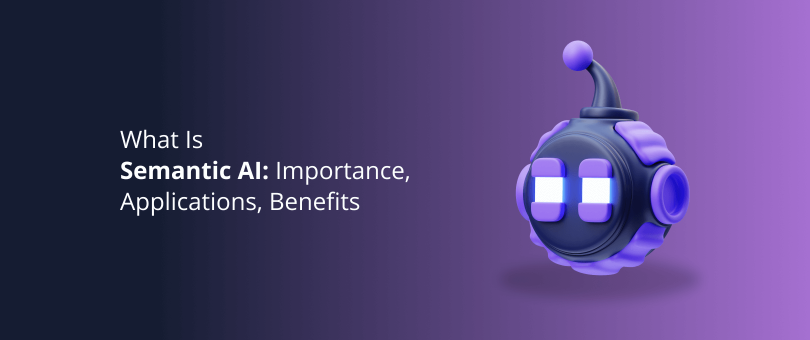Artificial Intelligence (AI) has revolutionized numerous industries, offering an unparalleled potential in data analysis, automation, and decision-making. Its transformative potential lies in the ability to process vast amounts of information and learn from it to make intelligent choices. As the AI market is forecasted to grow from $150.2 billion in 2023 to $1,345.2 by 2030 its impact is beyond imagination.
Among the various forms of AI, Semantic AI stands out. It is a powerful approach that focuses on understanding the meaning and context of data. By comprehending language and relationships between entities, it enables more human-like interactions, precise information retrieval, and contextually relevant responses. This advanced level of comprehension empowers AI systems to tackle complex challenges, making it a big player in shaping the future of intelligent technologies.
This article delves into the significance of Semantic AI, its benefits and drawbacks, and its applications in the business world. Continue reading to discover further insights and understand how Semantic AI is changing the way companies operate and interact with their customers.
Readers also enjoy: How to Use Artificial Intelligence in eCommerce – DevriX
What is Semantic AI?
Semantic AI, which includes natural language processing (NLP) and natural language understanding (NLU), is the branch of AI that focuses on understanding the meaning of language. It enables machines to grasp the context of user queries, leading to more accurate and relevant search results.

Essential Aspects of Semantic AI
Here are a few main aspects of semantic AI:
- Natural Language Understanding (NLU). NLU is a core aspect of Semantic AI, it focuses on the ability of machines to comprehend and interpret human language in a manner that goes beyond simple keyword matching.
- Natural Language Generation (NLG). NLG focuses on generating human-like language output from structured data. It enables AI systems to create informative and contextually appropriate responses.
- Knowledge Graphs. Semantic AI involves constructing and utilizing knowledge graphs, which are structured representations of information, linking entities and their relationships. Knowledge graphs enable AI systems to make connections between different data points, enhancing data organization and retrieval.
- Contextual Analysis. This allows AI systems to consider the context surrounding a piece of information. Thus providing more relevant and accurate responses to user queries.
- Entity Recognition. This process identifies specific entities such as people, places, organizations, or concepts within text data. This is vital because it allows AI to extract meaningful information from unstructured data.
- Sentiment Analysis. Another key aspect is sentiment analysis, which involves understanding and determining the sentiment of the expressed text. This helps discern the emotions, opinions, or attitudes conveyed in user feedback or content.
- Semantic Search. Here searches become more accurate and the results are more contextually relevant,enhancing the overall search experience.
- Contextual Recommendation. With Semantic AI, search recommendation can be enhanced to provide more personalized and contextually relevant suggestions to users based on their preferences, behaviors, and interactions.
- Disambiguation. This helps to ensure the accuracy of language comprehension, addressing any ambiguities or misinterpretations of words or phrases within a given context.
- Inference and Reasoning. AI systems can now draw reasonable conclusions, make logical inferences, and apply knowledge to solve problems or answer complex questions thanks to inferential and reasoning abilities.

Applications of Semantic AI
From revolutionizing customer support with virtual assistants to enhancing search engines’ accuracy, Semantic AI is driving significant advancements in natural language processing and understanding.
Integration With Search Engines
Integrating Semantic AI into search engines such as Google, Bing or DuckDuckGo will improve not only the quality, but the relevance of the results. Searches will align more closely and accurately to what a person is looking for.
Readers also enjoy: 6 Benefits of Sentiment Analysis and Opinion Mining in Marketing
Customer Service
Semantic AI finds one of its most significant applications in customer service. Just a few examples of where it can be employed:
- Chatbots. Thanks to NLP chatbots are better at understanding and responding to customer inquiries using natural language.
- Auto Attendants. These are AI-powered systems designed to handle and manage incoming calls or messages without the need for human intervention. They utilize speech recognition and NLP technologies to understand callers, simulating human-like interactions.
- Agent Co-pilots. These NLU powered co-pilots work alongside humans to enhance their performance, improve efficiency, and customer experiences.
- Multilingual Support. With Semantic AI, customer service can be provided in multiple languages, catering to a global and diverse customer base.
- Virtual Assistants. Semantic AI powers virtual assistants such as Alexa that can understand and respond to customer queries, offering personalized support and information.
Recommendation Systems
Semantic AI enhances recommendation systems by analyzing user preferences and behavior to offer more personalized and targeted product or content recommendations. For example:
- Personalized Product Recommendations. eCommerce platforms use Semantic AI-powered recommendation systems to analyze customer preferences, behavior, and past purchases.
- Content Recommendations. Media streaming services leverage AI to understand users’ interests, viewing history, and content preferences. This enables them to provide personalized content recommendations, such as movies, TV shows, or music, tailored to individual user tastes, thereby enhancing user engagement and satisfaction.
- News and Article Recommendations. Semantic AI can analyze users’ reading patterns, interests, and contextual relevance to offer more personalized news recommendations.
- Restaurant and Travel Recommendations. Semantic AI-powered recommendation systems consider factors like location, user reviews, dietary preferences, and past experiences to suggest restaurants or travel destinations that match users’ preferences, making the decision-making process easier and more personalized.

Natural Language Processing (NLP) in Healthcare
Semantic AI aids in extracting insights from medical literature, patient records, and research articles, facilitating better clinical decision making and medical research. Here are four examples:
- Clinical Documentation and Electronic Health Records (EHR). NLP is used to extract relevant information from clinical notes, physician reports, and other text-based records, converting them into structured data for easy analysis and retrieval. This streamlines data entry and improves the accuracy of patient records.
- Clinical Decision Support Systems. NLP-powered clinical decision support systems can analyze medical and patient data to provide evidence-based treatment recommendations to healthcare providers. This assists in making well-informed decisions and improving patient outcomes.
- Pharmacovigilance and Adverse Drug Event Detection. NLP algorithms can scan large volumes of text data, such as electronic health records and medical literature, to identify and track safety issues associated with medications. This aids in drug safety monitoring and regulatory compliance.
- Patient Communication and Virtual Health Assistants. NLP enables systems to answer patient inquiries, schedule appointments, and provide health-related information that enhances patient engagement and facilitates access to healthcare services.
Knowledge Management
Semantic AI is utilized in organizing and extracting insights from vast knowledge bases, enabling better information retrieval and knowledge sharing within organizations.Here are a few examples:
- Enterprise Knowledge Base. Semantic AI can be used to build and manage a comprehensive enterprise knowledge base by extracting context from various documents, emails and internal resources. Thus enabling and more efficient collaboration within organizations.
- Intelligent Search and Information Retrieval. Semantic AI improves searches within knowledge management systems. By understanding its user queries, it provides more accurate and contextually relevant search results, improving information retrieval and access to relevant knowledge.
- Automated Content Tagging and Categorization. Semantic AI can automatically tag and categorize content, ensuring that information is well-organized and easily retrievable.
- Knowledge Graph Construction. Semantic AI is used to construct and maintain knowledge graphs, representing relationships between different entities and concepts. Knowledge graphs facilitate the understanding and improve the navigation and discovery of interconnected knowledge within an organization.
Advantages of Semantic AI
Businesses can learn a lot from this technology, including better decision-making, increased productivity, and enhanced customer service.
- Efficiency. Semantic AI enables more efficient data processing and comprehension, leading to faster and more accurate results.
- Personalization. AI systems can offer personalized experiences based on individual preferences and behaviors.
- Contextual Understanding. Semantic AI’s contextual understanding allows AI systems to interpret user queries better, leading to more accurate responses that better address user intent.
- Improved Decision Making. The decision making process can now analyze large volumes of complex data. Businesses can leverage this to gain valuable insights and make data-driven choices for strategic planning and operations.
- Enhanced User Experience. Semantic AI improves user experiences by being more intuitive and acting more natural. This lets users communicate with AI systems in a way that feels more human-like and user-friendly.
- Accurate Information Retrieval. Semantic AI’s ability to better understand the meaning and context of language ensures that users receive the most precise and useful information based on their queries.
- Continuous Learning and Adaptation. This capability allows AI systems to improve over time, providing better and more up-to-date assistance and recommendations.
Readers also enjoy: 7 Proven Strategies for Integrating SEO and SEM to Maximize ROI – DevriX
Drawbacks and Concerns of using Semantic AI
The application of Semantic AI brings remarkable advancements, but it also presents certain drawbacks and concerns such as:
- Complexity and Development Costs. Implementing Semantic AI requires work. Building knowledge graphs, training NLP models, and managing semantic data can be costly and time-consuming.
- Data Privacy and Security Concerns. Semantic AI often requires access to large datasets and sensitive information, and this raises more than a few privacy and security concerns, especially in industries like healthcare and finance where data protection is vital.
- Interpretability Challenges. AI models can be difficult to interpret, leading to misinterpretation and decision making issues.
- Limited Contextual Understanding. While Semantic AI improves contextual understanding, it may still struggle with complex and nuanced contexts. In certain cases, AI systems may misinterpret user queries or provide inaccurate responses due to limitations in comprehension.
- Dependency on High-Quality Data. Semantic AI heavily relies on quality data for training and knowledge representation. Inaccurate or biased data can lead to faulty results and biased outcomes.
- Resource Intensive. Semantic AI requires substantial resources, making it challenging to deploy in resource-constrained environments or on low-powered devices.
- User Adaptation Challenges. there can be difficulties in understanding user-specific or domain-specific language, especially in niche industries or specialized fields.
- Integration Complexity. Integrating Semantic AI with existing systems and workflows can be complex, particularly when transitioning from traditional AI or rule-based systems.
Wrap Up
By bridging the gap between human language and machine comprehension, Semantic AI opens new possibilities for more sophisticated and empathetic AI interactions, providing us with endless opportunities for advancements in technology and user experiences.
However, as Semantic AI evolves, challenges emerge as well. Collecting accurate data while addressing ethical concerns and privacy issues that arise emphasizes the need for responsible AI development to prevent biases and misuse.
Striking the right balance between innovation and safety is crucial for unlocking Semantic AI’s full potential.




